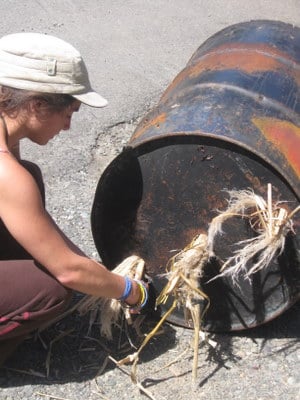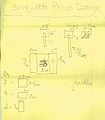
Description
Our objectives are to develop an efficient and production type of briquetting machine made from locally available materials; test different agr. waste materials; test the performance of the machine in terms of compaction ratio, evaluate the firmness of the briquettes, and calculate their heat value[1]
Overview
The criteria will help us best judge our project outcome and priorities for the project.
| Criteria | Definition | Constraints | Weight (0-10 highest) |
|---|---|---|---|
| Low/clean emission | This means reducing emissions, creating a clean burning fuel | 10 | |
| Use of local materials | biomass and press materials should be locally derived | The crops (sugarcane, rice, bamboo) of interest for research are not local to our area. However we are using the local invasive pampas grass. | 10 |
| Cultural appropriateness | The use and design of the briquette press and the biomass material, as well as the process of making charcoal should be appropriate to the local culture. | This project is not appropriate to our local culture and climate | 10 |
| Cost | should be affordable | costs of metal labor, biomass, and materials vary | 7 |
| Briquette efficiency | Briquettes should be heat efficiency, with an appropriate briquette to meal ratio | 9 | |
| Briquette durability | Briquettes should stay binded and consistent | Local climate impacting moisture content affecting durability | 8 |
| Press Durability | The briquette press should sustain its design and hold up to press large loads of briquettes | We will not make as much briquettes or have enough time as needed to test real durability. | 7 |
Timeline
Throughout the Spring Semester of 2010, group members researched, designed, tested, and reported on this project. Below are the completed tasks with the representative dates completed. Weather conditions proved difficult during times, thus explaining the density of work at particular dates.
- Week of March 7th- Receive order of sugarcane bio-waste, purchase binder, construct burning chamber from 55 gallon drum.
- Week of March 7th- Harvest locally invasive Pampas Grass from the community.
- Weekend of March 13th- First runs of charcoal manufacturing.
- March 25th- Design and manufacture charcoal press with scrap metal and some welding.
- March 15th-31st- More runs of charcoal production with various materials, binders, and press techniques.
- Beginning of April- Comparative data analysis from previous runs of charcoal production to determine best technique/materials.
- End of April- Results of project discussed, and information provided via appropedia.
Budget
| Quantity | Material | Source | Cost ($) | Total ($) |
|---|---|---|---|---|
| 1 | Rocketstove | Stove tech | $40.00 | $40.00 |
| 1 lb | binder | Coop | $.99 | $.99 |
| 27 lbs | Agriculture waste | various | donated/shipping cost | $27.00 |
| 15 lbs | metal | metal salvage shop | $10.00 | $10.00 |
| 1 | 55g oil drum | metal salvage shop | $12.00 | $12.00 |
| 2 hrs | labor for briquette press | Jordan King | Donated | $20.00 |
| 10 | plastic trashbags | Grocery Store | $5.00 | $5.00 |
| 4 | bowl/mixing supplies | Personal Possession | Free | $5 |
| 1 | digital thermometer | Personal Possession | Already had (but only needed for testing purposes) | $30 |
| Total Cost | $150 Total worth | |||
| Total Cost | $95 Total Spent | |||
Briquette Press Design
- Briquette Press Design
-
-
Action of the press
-
Prototype for press
-
-
Finished press parts
The Process
Preparation (varies)
-
Kiln/vessel with lid for carbonizing, we used a 55 gallon drum (being cleaned in this image)
-
Gathering Biomass
-
We used the local invasive Pampas grass as well as a some cattail
Steps
Briquettes
- Sift the crushed charcoal to separate larger and/or uncarbonized pieces.
- Mix binder. We used wheat flour mixed with water. The binder should be a thick, sticky porridge-like consistency.
- Combine binder & charcoal. The less the binder is needed, the more ideal. 10%-90% ratio would be ideal and 50%-50% would be too much.
- Make briquette using the press.
- Dry briquettes.
- Making Briquettes
-
Sifting
-
placing in press
-
pressing
-
removing from press
-
removed briquette
-
drying
-
more drying
Results
Briquette Process
| Batch Number | Amount of Ash | Amount of Binder | Briquette Dimensions (cm3) (length x width x height) | Density (gram/cubic centimeter) |
|---|---|---|---|---|
| One | One cup | 4 tablespoons | 4.5x7x1.9 | 0.42439 gram / cubic centimeter |
| One | One cup | 2-3 tablespoons | 4.5x7x2.1 | 0.24943 gram / cubic centimeter |
| One | One cup | 3 tablespoons | 4.5x7x3 | 0.59788 gram / cubic centimeter |
| One | Two cups | 3 tablespoons | 4.5x7x2.5 & 4.5x7x2.4 | 0.44063 gram / cubic centimeter & 0.38888 gram / cubic centimeter |
| One | One cup | 2 tablespoons | 4.5x7x2.0 | 0.31111 gram / cubic centimeter |
| Two | 3 cups | 9 tablespoons | 4.5x7x2.7 & 4.5x7x2.0 | 0.42093 gram / cubic centimeter & 0.39047 gram / cubic centimeter |
| Two | 3 cups | 6 tablespoons | 4.5x7x2.6 & 4.5x7x2.3 & 4.5x7x1.6 | 0.42735 gram / cubic centimeter & 0.42788 gram / cubic centimeter & 0.36309 gram / cubic centimeter |
| Two | 1 cup | 2 tablespoons | 4.5x7x1.8 | 0.22575 gram / cubic centimeter |
| Two | 1 cup | 3 tablespoons | 4.5x7x2.0 | 0.46031 gram / cubic centimeter |
Stove Tests
| Trial # | # of Briquettes Used | Range in Temp. | Burn Time | Comments |
|---|---|---|---|---|
| One | One briquette | 65of-85of | 40 minutes | One briquette is not enough to bring water to boil, failed first run. |
| Two | Four briquettes | 75of-180of | 1 hour 10 minutes | Started with two briquettes and brought water to 105of, added two more briquettes and brought the temperature up to 180of. Nearly boiling conditions. |
| Three | Five briquettes | 75of-210of | 45 minutes | Started the burn with three briquettes and broke each in half to increase surface area which brought temp to 165of. At 23 minutes added two more briquettes in similar fashion to achieve boiling of the water. Most appropriate for cooking a meal with a short cooking time |
| Four | Six briquettes | 75of-220of | 55 minutes | Started the burn with three briquettes and got temp to boiling point very fast (<10 minutes), then added three more briquettes quite early. Brought the water to a vigorous boil and then allowed boil to occur. Since we added the briquettes in a condensed amount of time, the total burn time was shorter but the maximum temp was reached. Most appropriate for cooking a meal that has a long cooking time. |
| Five | Five briquettes | 75of-220of | 20 minutes | Added all briquettes at the beginning and like the other runs, broke them all in half. Quickest time to boil (8.5 minutes) out of all the runs done. The boil was sustained for 18 minutes then died down to a simmer for another 15 minutes. Most appropriate for flash boiling water to purify. |
Testing
Intended Use
This process and press is intended for small families and/or communities. There are presses and grinders that have been made for higher production rates and industrial uses. For best maintenance of the press, it is ideal to clean it out when each session is finished. There can be a main entity who produces the charcoal and one who produces briquettes as well. The briquettes can be for personal use or made to be sold. Because local knowledge and processes of producing the charcoal and the appearance(minus the shape) are altered little, the briquettes have a better chance of being adopted in place of regular wood charcoal.
Conclusion
Our tests produced about 12 briquettes per barrel of biomass.
It takes about 3 hours to make the charcoal itself, and about 1 hour to make the 12 briquettes -including preparing and sifting. The whole process is about 5-6 hours including preparation and clean up.
Number of briquettes that could be made in a day with one barrel, are about 24-30
Our tests resulted in about an average of 6 briquettes per meal. With 3 meals a day, that is about 18 briquettes from one days use of fuel.
These results will vary with biomass used and how efficient the carbonizing process is.
Throughout the project we ran into many constraints including time, local culture, and most importantly climate. The collecting of biomass to burn was fairly simple, but the drying process was made significantly more difficult by the constant occurrence of rain and heavy local moisture. The rain not only made for difficult drying, but also for difficultly burning and drying of the briquettes. The results of our charcoal production in the majority of our trials were either inefficient or were unsuccessful due to wet biomass. The local culture of Humboldt County is committed to environmentally sound thought, but the lack of knowledge and irregular use of charcoal made collecting information much more difficult. Without local resources, we were forced to rely on information pertaining to different culture's approaches to charcoal making, and not our own. Because there is not a local demand for this project, the use of local materials and methods can now be used as a template for cultures with similar constraints to expand the sphere of knowledge surrounding the process. Our analysis from the data gathered leads us to believe that the single family production of briquettes for personal use would not likely be efficient, because of the amount of materials needed and labor required for the output. It would take approximately ten 55 gallon oil drums of unburnt biomass to produce briquettes for a small family to cook with for a week (see calculations above). If the labor was instead preformed by a group of laborers with access to numerous oil drums and large quantities of biomass, the time spent with production could be far more efficient. The laborers could then focus solely on the task, and distribution within the community could be focused to make the entire process as efficient as possible both socially and economically. The entire process was very informative and fun, with challenging aspects that needed to be overcome or worked around. The designing and building of the charcoal press was a particularly fun aspect, as well as burning the product that we spent so much time creating! This was a great project that looks at an issue of vast importance all over the world, with many areas that could be affected in the near future.
Template:Attrib class
- ↑ Barnard,Geoffrey and Lars Kristoferson. Agricultural Residues as Fuel in the Third World. Technical Report No.4. London: IIED, 1985




















